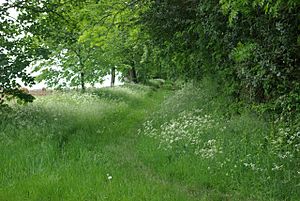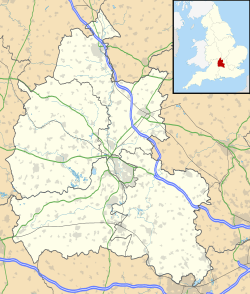Aves ditch facts for kids
Aves Ditch is an ancient earthwork in Oxfordshire, England. It's also known by other names like Ash Bank or Wattle Bank. This structure is made up of a ditch and a bank of earth. It stretches for about 3 miles (5 km) from the northeast to the southwest.
Aves Ditch is located in the Cherwell District. Today, it marks the border between two local areas called Lower Heyford and Middleton Stoney.
What is Aves Ditch?
Aves Ditch is a long, man-made feature in the landscape. It consists of a trench (the ditch) and a raised mound of earth (the bank). This type of structure is called an "earthwork."
It was built a very long time ago, during the Iron Age. The Iron Age was a period in history when people started using iron tools.
History of Aves Ditch
For a long time, people thought Aves Ditch was a Roman road. The Romans were famous for building many roads across Britain.
However, archaeologists dug up parts of the ditch to study it. These studies showed that it was not a Roman road at all. Instead, it was an Iron Age "boundary dyke." A dyke is a type of wall or ditch, often used to mark a border.
Archaeologists also found a skull in the ditch. This skull was from the Anglo-Saxon period, which came after the Roman period. This suggests that the ditch was used again much later, during Anglo-Saxon times.
Who Built It?
Experts believe Aves Ditch was built by ancient people during the Iron Age. It likely served as an important boundary.
Some historians, like Sauer and Lambrick, think Aves Ditch helped separate different Iron Age tribes. These tribes were groups of people living in specific areas. They suggest it might have been the border between the Dobunni and the Catuvellauni tribes.
Other similar earthworks in the area, like the North Oxfordshire Grim’s Ditch and the South Oxfordshire Grim’s Ditch, might have been part of the same large boundary system.



